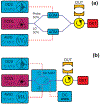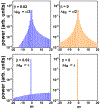Single-modulator, direct frequency comb spectroscopy via serrodyne modulation
- PMID: 36790968
- PMCID: PMC10910350
- DOI: 10.1364/OL.482597
Single-modulator, direct frequency comb spectroscopy via serrodyne modulation
Abstract
Traditional electro-optic frequency comb spectrometers rely upon the use of an acousto-optic modulator (AOM) to provide a differential frequency shift between probe and local oscillator (LO) legs of the interferometer. Here we show that these modulators can be replaced by an electro-optic phase modulator (EOM) which is driven by a sawtooth waveform to induce serrodyne modulation. This approach enables direct frequency comb spectroscopy to be performed with a single dual-drive Mach-Zehnder modulator (DD-MZM), allowing for lower differential phase noise. Further, this method allows for simpler production of integrated photonic comb spectrometers on the chip scale.
Figures





References
-
- Parriaux A, Hammani K, and Millot G, Adv. Opt. Photonics 12, 223–287 (2020).
-
- Wong KK, De La Rue RM, and Wright S, Opt. Lett 7, 546–548 (1982). - PubMed
-
- Johnson LM and Cox CH, J. Lightwave Technol 6, 109–112 (1988).
-
- Laskoskie C, Hung H, El-Wailly T, and Chang CL, J. Lightwave Technol 7, 600–606 (1989).
-
- Poberezhskiy IY, Bortnik B, Chou J, Jalali B, and Fetterman HR, IEEE J. Quantum Electron 41, 1533–1539 (2005).
Grants and funding
LinkOut - more resources
Full Text Sources

